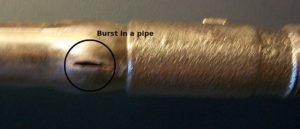Preventing Frozen Pipes
go.ncsu.edu/readext?502290
en Español / em Português
El inglés es el idioma de control de esta página. En la medida en que haya algún conflicto entre la traducción al inglés y la traducción, el inglés prevalece.
Al hacer clic en el enlace de traducción se activa un servicio de traducción gratuito para convertir la página al español. Al igual que con cualquier traducción por Internet, la conversión no es sensible al contexto y puede que no traduzca el texto en su significado original. NC State Extension no garantiza la exactitud del texto traducido. Por favor, tenga en cuenta que algunas aplicaciones y/o servicios pueden no funcionar como se espera cuando se traducen.
Português
Inglês é o idioma de controle desta página. Na medida que haja algum conflito entre o texto original em Inglês e a tradução, o Inglês prevalece.
Ao clicar no link de tradução, um serviço gratuito de tradução será ativado para converter a página para o Português. Como em qualquer tradução pela internet, a conversão não é sensivel ao contexto e pode não ocorrer a tradução para o significado orginal. O serviço de Extensão da Carolina do Norte (NC State Extension) não garante a exatidão do texto traduzido. Por favor, observe que algumas funções ou serviços podem não funcionar como esperado após a tradução.
English
English is the controlling language of this page. To the extent there is any conflict between the English text and the translation, English controls.
Clicking on the translation link activates a free translation service to convert the page to Spanish. As with any Internet translation, the conversion is not context-sensitive and may not translate the text to its original meaning. NC State Extension does not guarantee the accuracy of the translated text. Please note that some applications and/or services may not function as expected when translated.
Collapse ▲When temperatures drop below freezing – especially for a significant amount of time – the potential for frozen pipes increases dramatically.
Before cold weather hits, here are some precautionary steps you can take:
- Know where and how to shut off your water from the main shut-off valve.
- Seal air leaks around pipes that allow cold air to seep in.
- Insulate pipes near outer walls, in crawl spaces or in attics.
- In exposed or problem areas, you may use heat tape or heat cables to prevent freezing. Make certain they are UL approved and that you follow manufacturers instructions.
- Disconnect garden hoses, shut off and drain water from pipes leading outside. Consider installing an insulated spigot cover.
- Turn your faucet on just enough to have constant dripping (for pipes that may be on exterior wall)
- Open cabinet doors to allow heat to circulate around pipes under a sink.
- Leave heat on and set no lower than 55 degrees.
- If you plan to be away from home, have someone check on your house daily.
- Close foundation vents if the temperature drops below freezing for a significant period of time. Re-open when weather warms.
If pipes freeze:
- Shut off water valves. Stopping the flow of water can minimize the damage to your home.

- Call a plumber to thaw your pipes. Thawing yourself can lead to greater damage and can be a hazard.
- If your pipes burst, call a plumber and your insurance agent.
Although attempting to thaw pipes yourself is NOT recommended, if you do try to thaw:
- Do not try to thaw the pipes with an open flame or torch.
- Do not use ungrounded electrical appliances outdoors, or near grounded water pipes.
- Be careful of the potential for electric shock in and around water.
- Never start a debris fire to warm pipes.
- When thawing pipes, always work from the open faucet toward the frozen area. This will keep steam from being trapped by ice and bursting the pipe.


